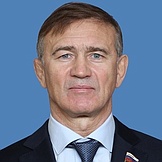Regional flags and emblems


Established 13 June 1934
Capital Kursk
The Kursk Region is part of the Central Federal District
Area 30,000 sq km
Population 1 050 100 (2025)
Ethnic groups,
(2020 National Census, %)
Russian – 95,93
Other – 4,07
Administrative divisions (2024)
Municipal districts − 28
City districts − 5
Rural towns − 27
Rural districts − 287
Geography and climate
The Kursk Region is located in the central part of the Eastern European Plain. The Region borders on the Bryansk, Orlov, Lipetsk, Voronezh, and Belgorod regions, as well as Ukraine.
The basins of the Dnieper (Seim, Psel) and Don rivers are located on its territory. The main type of soil is chernozem. The climate is temperate continental. January temperatures average –6.9°C, July temperatures average +19.1°C. Average precipitation in January is 50 mm; average precipitation in July is 94 mm.
The Kursk Region is home to eight specially protected natural areas, including the Alyokhin Central Chernozem State Biosphere Reserve and seven natural landmarks.
Government
The legislative branch is represented by the Kursk Region Duma, which is the permanent, representative and only body of legislative authority in the region. The Kursk Region Duma has 45 deputies elected for five years, with 22 of them running in the single electoral district, where winners are identified in proportion to the number of votes cast for lists of candidates nominated by electoral associations, and the other 23 in single-mandate constituencies.
The current Kursk Region Duma was elected in September 2021. Its term expires in September 2026.
The executive branch in the Kursk Region is represented by the Governor of the Kursk Region, the Government of the Kursk Region, which is the supreme body of executive authority in region, and other executive agencies of the Kursk Region. The regional government is the permanent body of executive authority, which coordinates the activities of other executive agencies of the Kursk Region. The government is headed by the First Deputy Governor of the Kursk Region – Prime Minister of the Kursk Region.
The Governor of the Kursk Region is the region’s highest-ranking official, who runs the executive branch in the region, determines the structure of the bodies of executive authority of the region and forms the Government of the region. The Governor is elected for five years by Russian citizens who permanently reside in the region. The Acting Governor will remain in office until an elected Governor of the Kursk Region assumes office.
Economy and natural resources
Industrial output accounts for about 35% of the regional GDP.
The region lies at the center of the world’s largest Precambrian iron-ore-rich megastructure known as the Kursk Magnetic Anomaly.
Ferrous metals, food, chemical and petrochemical industries, mechanical engineering and metal processing are well-developed in the region. The Region is home to one of Russia’s largest ferrous metals plants.
Iron ores are concentrated in over 30 deposits. The only open-cut pit is the Mikhailovskoye Iron Ore Deposit.
The region has prospected deposits of iron ore, phosphorites, peat, and building materials: chalk, fusible and refractory clays and loams, quartz sands. It is also rich in mineral waters.
Production and distribution of electricity, gas and water is ensured by a Rosenergoatom subsidiary, Kursk Nuclear Power Station, and by the stations of the Kurskenergo network. The Kursk Nuclear Power Station covers to 50% of the Central Federal District’s energy needs.
In agriculture, the share of crop production stands at 70%, and livestock production at 30%. Crop production focuses on grain and forage crops, sugar beets and potatoes, while the livestock breeding includes dairy farming and beef cattle breeding.
Favourable conditions are being created for business development and investment. The Kursk Region has economic ties with 73 countries. Imports are dominated by machine building products, food, chemical products, rubber, metals and metal products.
Culture and tourism
The Kursk Region as well as its capital, Kursk, has many monuments commemorating the Battle of Kursk and other battles of the Great Patriotic War. The village of Ponyri has a memorial complex honouring the heroes of the northern face of the Kursk Bulge.
The Kursk Region is rich in history and arts. Rylsk is one of the best-known cities in the region. It was founded in the 10th century on St Ioann of Rylsk Mount as a fortress. The town is noted for having largely preserved its old buildings (XVIII-XIX centuries) and does not have more recent architecture.
The principal church of Rylsk and one of the Kursk Region’s landmarks is the Church of the Intercession. Its form is that of a circle with protruding rectangular sections on three sides.
The Rylsk Regional History Museum has much to tell about the region’s past and natural wonders. The Maryino Estate of the Counts Baryatinsky is noted for its architecture and park, and is the gem of the village of Ivanovskoye in the Rylsk District. The estate was earlier the property of Getman Mazepa, and was taken from him by Tsar Peter the Great following his betrayal and given to the counts.
The village of Zapovedny, which is situated 10 km from Kursk, is home to the Alyokhin Central Chernozem State Biosphere Reserve. It is the world’s only example of a meadow forest steppe area. The reserve covers over 5,000 ha, and has 920 plant species.
The Kursk Region has preserved numerous locations connected with famous people. For instance, tourists can visit poet Afanasy Fet’s estate in the village of Vorobyovka in the Zolotukhino District. There is an old park with a pond, a two-storey mansion, auxiliary buildings that housed servants and the stables. The Village of Mokva is the site of a sanatorium, which stands next to the palace of Count Alexander Nelidov, the 19th-century Kursk Governor General. The palace was built in the early 19th century and is a mix of six different architectural styles.


